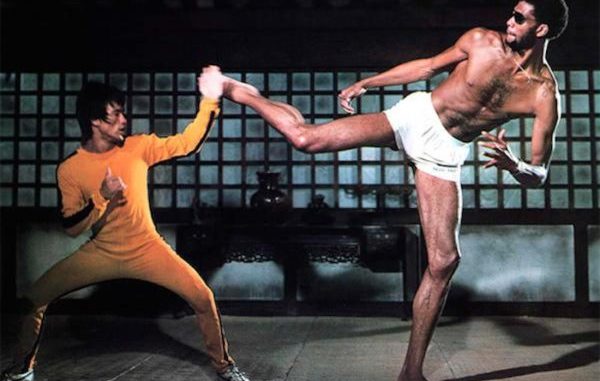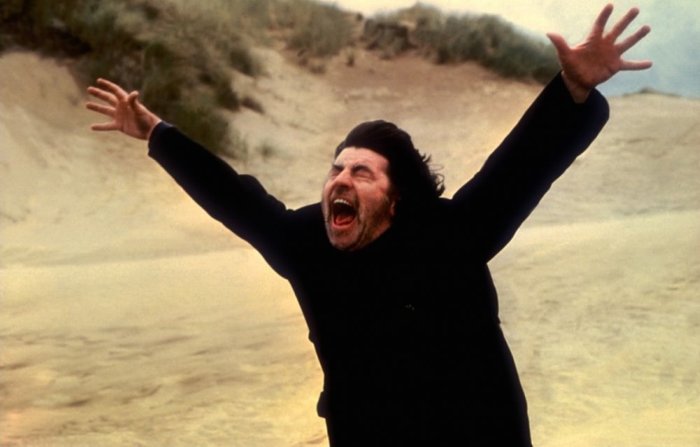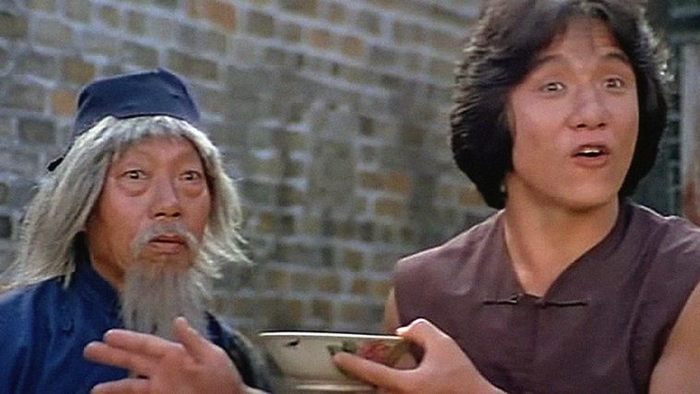Part of a deep dive into the films made in the year of my birth: 1978. This post is covering several films I watched while the idea was only gestating, so I’m going mostly off of memory here, except for a couple movies I only watched in the last week or so…
- The Shout – Hazy thriller in which an itinerant man (Alan Bates) injects himself into the lives of an experimental musician (John Hurt) and his wife (Suzannah York). Bates claims to have mystic aboriginal powers, notably the titular “Shout”, which he says has the power to kill anyone who hears it. Hurt, being a musician, becomes enamored with this idea, but Bates is sorta using it to disrupt Hurt’s marriage and you know what? The plot here is almost beside the point.
This is much more of a mood piece, with an ambient soundtrack (provided by the less-famous members of the band Genesis) and bizarre framing device to set the tone. At times cryptic and hypnotic, but it can also sometimes feel pointless and hollow. Great performances all around, though Bates’ quiet menace is clearly the standout, and the visuals work pretty well too. I have mixed feelings about this one. Not usually my sort of thing, but I still found it to be an interesting discovery. **
- The Last Waltz – Canadian-American rock group The Band ended their touring career with a spectacular blowout in 1976, featuring numerous celebrity guests including Bob Dylan, Neil Diamond, Neil Young, Joni Mitchell, Ringo Starr, and plenty of others. None other than Martin Scorsese filmed the concert and incorporated some interviews with The Band, releasing the whole package in this concert documentary. Generally, there’s not a whole lot to do with a concert-based film, and while the interviews interspersed throughout are fine, they don’t really sell the movie. The music itself is the real standout, and boy is it a spectacular series of guest appearances. I didn’t really know what I was getting into with this, and half expected it to be a sorta talking-heads documentary where a bunch of famous musicians opined on The Band’s influence, etc… But it turns out that they actually just join The Band onstage and play songs. And it’s great! Scorsese clearly knows what he’s doing and it it looks good too, but again, its not really the formal filmmaking that makes the movie; it’s the sheer number of huge stars that show up at this show that makes the whole thing worthwhile. I really enjoyed it much more than I thought I would and I’m glad that someone of Scorsese’s caliber was around to document it… but it’s clearly a document and not an actual “experience”. Of course, what document could ever really capture what this experience must have been like? ***
- Eyes of Laura Mars – A provocative fashion photographer (Faye Dunaway as the titular Laura Mars) begins having visions of murders seen through the eyes of a serial killer. The killer is orbiting Mars’ life, killing those involved in her work. A young Tommy Lee Jones (sporting a bitchin’ black turtleneck and jet black mane of hair) plays the police detective on the case. Rene Auberjonois and a larval Brad Dourif have worthy supporting roles. Tons of red herrings, approaching a sorta schlocky American take on Giallos, but not quite getting there, opting for more restraint and soft edges. It’s got small doses of sleaze, but not enough to really catapult it into competition with Exploitation or Giallo (and by this, I don’t mean that the film is any less valuable, and indeed it seems better received than it would have been if it really leaned into those elements). The final twist isn’t that hard to see coming, but also somehow feels a little off, like it doesn’t quite fit (that, at least, is very Giallo). Thematically, there’s some exploration of art and influence in culture, both explicitly in the text (Laura Mars’ work touches on the intersection between violence and sexuality in ways that are controversial) and implicitly in the way the story is told. The pacing drags for a while in the middle and I’m not entirely sure it sticks the landing, but it’s still a fascinating little slice of 70s filmmaking. **1/2
- Game of Death – Bruce Lee’s final film, he died during filming, leading filmmakers scrambling to assemble something usable from available footage. To accomplish this, the filmmakers use every trick in the book, ranging from mildly clever to face-palmingly dumb to breathtakingly tasteless. This is a movie that actually contains an actual shot of Bruce Lee’s actual corpse. That’s… disgusting. As a result of all this, the plot is disjointed at best, and Lee isn’t in lots of the movie, or is shrouded in shadows or some other trick used to get around the lack of footage. All of which is a real shame because the films finale, set in a pagoda, features some great action setpieces.

Basically a series of boss fights where Lee dons the famous yellow jumpsuit (homaged by Quentin Tarantino and Uma Thurman in Kill Bill: Vol. 1) and fights his way through several henchmen, including the, uh, much, much taller Kareem Abdul Jabbar. Ultimately the film is more interesting as the result of a historical trainwreck than as a film by itself. It’s an ethically and morally corrupt attempt to cash-in on a dead movie star, but there are some transcendent moments in the film too. This makes traditional ratings here kinda hard, but let’s just go **
- Xenogenesis (short) – A 12 minute short film co-directed by James Cameron and Randall Frakes, this is the sort of thing that fans of Cameron would get a kick out of. Some of his most famous ideas from The Terminator and Aliens have their roots here. It’s also pretty clearly inspired by Star Wars (which came out the year before). As a piece of filmmaking, it’s pretty clunky, starting with a big chunk of voiceover exposition laid over still shots of artwork, then moving to a live action encounter between a pair of explorers and a spaceship security robot thing. Some of the visuals are striking (sometimes approaching a sorta proto-TRONlook), and the technique on display is pretty good considering the shoestring budget. You’ll recognize the robot as a similar design to the Hunter Killer tanks from The Terminator and the idea of a woman in an exoskeleton saving the day was clearly repurposed in Aliens. It’s short and it works fine, but it’s really only of interest to Cameron completists (but if you are one of those, then you’ll enjoy this). **
- Snake in the Eagle’s Shadow – After trying (and failing) to make Jackie Chan the next Bruce Lee, the studios let Chan do his own thing, which basically meant incorporating more comedic elements into his films. This movie is Chan’s breakout effort, teaming up with legendary fight choreographer and director Woo-Ping Yuen (normal Americans probably know him best for his work on The Matrix, but he’s huge in Martial Arts cinema). Chan plays an orphan adopted by a man who runs a martial arts school. Chan’s character is a lovable, good-natured punching bag who is picked on by the rest of the school. One day he runs into an old man being attacked and rushes to help. Grateful, the old man teaches Chan the Snakefist style. Chan is then able to stand up to the bullies at his school, but then learns that adherents to the Eagle’s Claw style are attempting to wipe out all the Snakefist masters, including his old friend.
This is a standard Martial Arts plot and not really the point, but it’s pretty well packed with excellent action set pieces and well choreographed fights. Woo-Ping Yuen’s intricate style pairs well with Jackie Chan’s trademark improvisational nonsense (well, that’s a misnomer because Chan’s trademark style is neither improvisational nor nonsense, but it appears that way and is a big part of his charm). This is clearly an early, not quite fully formed Jackie Chan, but it’s still a great movie. The actor Siu-Tien Yuen plays the old man who trains Chan, and he’s fantastic (and also, he’s the real-life father of director Woo-Ping Yuen). Finally, this film has the greatest death scene in all of cinema history. Good stuff and maybe my favorite discovery yet. ***
- Drunken Master – Jackie Chan followed up his success by reteaming with both Woo-Ping Yuen and Siu-Tien Yuen for what might be his most famous early work, the one that really catapulted him into stardom. However, Chan’s character is a bit less likable here, playing the spoiled son of a famous Kung Fu instructor. He causes trouble everywhere, in some cases justified (as when he defects a local merchant from another spoiled brat), and in others emphatically not (as when he tricks a girl into hugging and kissing him, though at least in this case the girl’s mother kicks the crap out of him in a great scene). Fed up with his kids antics, the father sends him off to train with his great uncle, a teacher notorious for strict training methods and discipline. Eventually, Chan’s character starts to wise up, learns his new teacher’s secret style of “Drunken Boxing” and uses it to help defend the family clan from an assassin. Like Snake in the Eagle’s Shadow, this is a very well executed martial arts movie. The trio of Jackie Chan, Woo-Ping Yuen, and Siu-Tien Yuen work really well together and that chemistry shows up onscreen. Filled with more of Chan’s patented slapstick and intricate fight choreography, including the creative and entertaining Drunken Boxing style, this is another film with a high density of action sequences, and they’re all fun to watch. Chan’s character is a bit of a dolt, but it is fun watching him get beat up for it. It’s funny, there was a recent story about how The Rock and Jason Statham have lines in their contract about how they can’t lose a fight in a movie, the number of punches they can take, etc… Meanwhile, in the two Jackie Chan movies covered in this post, Chan is getting his butt kicked pretty consistently, which of course allows him an arc to grow and fight back. There’s a few sequels to this movie, but I honestly enjoyed this one the best. Indeed, I’m not sure which of these I like better… ***
That’s all for this first update. I’m sure I’ll get to some 1978 stuff during the Six Weeks of Halloween horror movie marathon, but the next formal update will probably be sometime in November/December.

